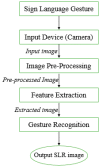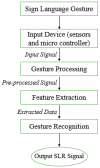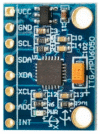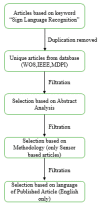A Comparative Review on Applications of Different Sensors for Sign Language Recognition
- PMID: 35448225
- PMCID: PMC9027924
- DOI: 10.3390/jimaging8040098
A Comparative Review on Applications of Different Sensors for Sign Language Recognition
Abstract
Sign language recognition is challenging due to the lack of communication between normal and affected people. Many social and physiological impacts are created due to speaking or hearing disability. A lot of different dimensional techniques have been proposed previously to overcome this gap. A sensor-based smart glove for sign language recognition (SLR) proved helpful to generate data based on various hand movements related to specific signs. A detailed comparative review of all types of available techniques and sensors used for sign language recognition was presented in this article. The focus of this paper was to explore emerging trends and strategies for sign language recognition and to point out deficiencies in existing systems. This paper will act as a guide for other researchers to understand all materials and techniques like flex resistive sensor-based, vision sensor-based, or hybrid system-based technologies used for sign language until now.
Keywords: K-Nearest Neighbor; accelerometer sensor; artificial intelligence; decision tree; discriminant analysis; flex sensors; gesture recognition; gyroscope; machine learning; man-machine interface; sensor; sign language; supervised and unsupervised learning; support vector machine.
Conflict of interest statement
The authors declare no conflict of interest.
Figures






















References
-
- Bhatnagar V., Magon R., Srivastava R., Thakur M. A Cost Effective Sign Language to voice emulation system; Proceedings of the 2015 Eighth International Conference on Contemporary Computing (IC3); Noida, India. 20–22 August 2015.
-
- Masieh M.A. Smart Communication System for Deaf-Dumb People; Proceedings of the International Conference on Embedded Systems, Cyber-physical Systems, and Applications (ESCS); Athens, Greece. 2017; [(accessed on 21 December 2021)]. Available online: https://www.proquest.com/openview/2747505eab9eb43cb1717f9654ca7d16/1?pq-....
-
- Kashyap A.S. Digital Text and Speech Synthesizer Using Smart Glove for Deaf and Dumb. Int. J. Adv. Res. Electron. Commun. Eng. (IJARECE) 2017;6:4.
-
- Amin M.S., Amin M.T., Latif M.Y., Jathol A.A., Ahmed N., Tarar M.I.N. Alphabetical Gesture Recognition of American Sign Language using E-Voice Smart Glove; Proceedings of the 2020 IEEE 23rd International Multitopic Conference (INMIC); Bahawalpur, Pakistan. 5–7 November 2020; pp. 1–6. - DOI
-
- Lokhande P., Prajapati R., Pansare S. Data Gloves for Sign Language Recognition System. Int. J. Comput. Appl. 2015;975:8887.
Publication types
LinkOut - more resources
Full Text Sources
Miscellaneous

